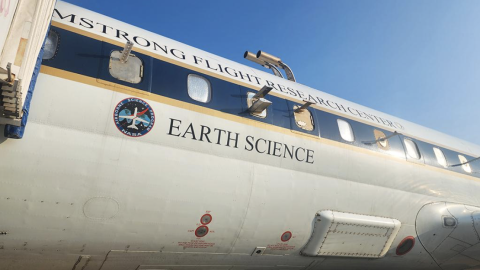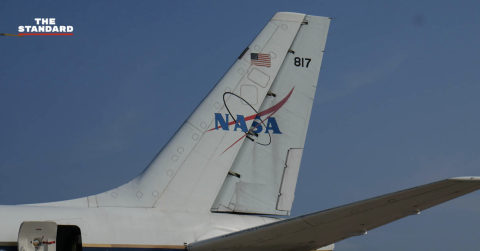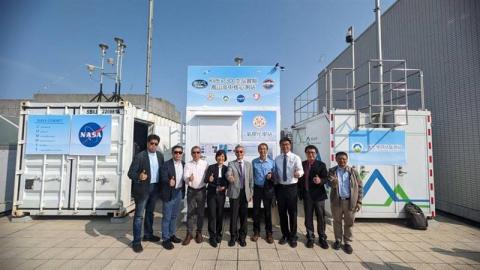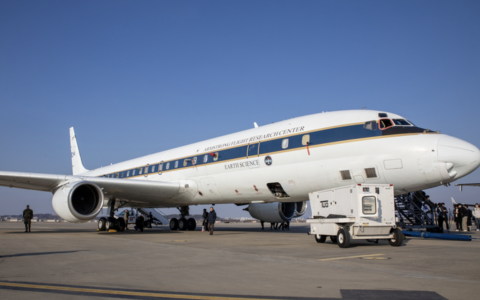Chiang Mai, the largest city in northern Thailand, is famed for having hundreds of Buddhist temples, some of which date to the city’s founding in the 13th century. This rich history—and easy access to hiking, waterfalls, and hot springs in the surrounding highlands, as well as being the setting of a hit movie in 2012—has turned the city into a hub of tourism that hosts as many as 10 million visitors per year.
News
Grappling with Thailand’s Seasonal Haze

Each year in January and February, satellites begin to detect waves of smoke and fire in Southeast Asia, particularly in highland forests in Cambodia, Laos, Myanmar, and Thailand. Fire activity continues to increase through March and April, reaches a peak during the height of the dry season, and then fades in May with the start of the rainy season.
Individual fires are usually small and short-lived. But they are often so numerous that smoke, along with air pollution from rural and urban areas, mixes to produce thick layers of haze that blanket the landscape. Such hazes contain mixtures of small airborne particles called aerosols and gaseous pollutants such as nitrogen dioxide, sulfur dioxide, carbon monoxide, and ozone that degrade air quality and have harmful health effects.
In spring 2024, an international field campaign—ASIA-AQ (Airborne and Satellite Investigation of Asian Air Quality)—headed to Thailand to take a close look at the haze. During the last two weeks of March 2024, NASA’s DC-8 and Gulfstream III aircraft flew several flights over Chiang Mai, Bangkok, and rural areas surrounding the cities to sample air quality with several sensors. At the same time, satellites observed the haze from above.
NASA’s DC-8 Completes Final Mission, Set to Retire

NASA - The DC-8 aircraft returned to NASA’s Armstrong Flight Research Center Building 703 in Palmdale, California, on April 1, 2024, after completing its final mission supporting Airborne and Satellite Investigation of Asian Air Quality (ASIA-AQ). The aircraft and crew were welcomed back with a celebratory water salute by the U.S. Air Force Plant 42 Fire Department.
Langley Celebrates Women’s History Month: The Langley ASIA-AQ Team
In honor of Women’s History Month, we caught up with the ASIA-AQ team on the other side of the Earth and asked the women from Langley about their inspirations and challenges as scientists. The ASIA-AQ (Airborne and Satellite Investigation of Asian Air Quality) mission is an international cooperative field study designed to address local air quality challenges. ASIA-AQ will contribute to improving the integration of satellite observations with existing air quality ground monitoring and modeling efforts across Asia.
Langley Celebrates Women’s History Month: The Langley ASIA-AQ Tea

NASA - In honor of Women’s History Month, we caught up with the ASIA-AQ team on the other side of the Earth and asked the women from Langley about their inspirations and challenges as scientists.
The ASIA-AQ (Airborne and Satellite Investigation of Asian Air Quality) mission is an international cooperative field study designed to address local air quality challenges. ASIA-AQ will contribute to improving the integration of satellite observations with existing air quality ground monitoring and modeling efforts across Asia.
Deep dive into important missions with NASA's G-3 aircraft

GISTDA - GISTDA joins with NASA to survey and collect air data in Thailand with the ASIA-AQ mission.
In-depth look at the important missions of NASA's G-3 (Gulfstream-3) aircraft. What main missions does this aircraft have? Interview with Laura Judd, a NASA science researcher who planned the operation of the G-3 small plane.
Deep dive into important missions with the DC-8, NASA's large aircraft on this mission

GISTDA - GISTDA joins NASA to survey and collect air data in Thailand with the ASIA-AQ mission.
In-depth look at the important missions of NASA's DC-8 (Douglas DC-8) aircraft. What main missions does this aircraft have?
Interview with Jim Crawford, Senior Scientist NASA's Atmospheric Chemistry Department, who is planning the operation of the DC-8 aircraft.
NASA Lauds ASIA-AQ Mission DC-8’s Ability To Assess Air Quality

Aviation Week Network - Nearly 55 years since its first flight, NASA’s McDonnell Douglas DC-8-72 is on the last legs of its flying service in a two-month tour to Asia to measure air quality in four key countries and territories. Under the banner of the Airborne and Satellite Investigation of Asian Air Quality (ASIA-AQ).
Fusion PTR-TOF Aboard NASA DC-8 Over the Philippines

AZO Materials - IONICON Analytik - The world's biggest airborne laboratory, a NASA DC-8 aircraft, has arrived in the Philippines for the first leg of its multiple country mission around Asia. Aboard the DC8 are two IONICON FUSION PTR instruments, one to monitor the gas phase and one IONICON FUSION PTR-TOF 10k equipped with a CHARON inlet system to monitor particles. We are very excited to be part of the NASA mission ASIA-AQ.
NASA and GISTDA team up to clear the air with ASIA-AQ project

Thaiger - In a groundbreaking initiative, the National Aeronautics and Space Administration (NASA) has joined forces with Thailand’s Geo-Informatics and Space Technology Development Agency (GISTDA) to tackle the pervasive issue of air pollution through the Airborne and Satellite Investigation of the Asian Air Quality (ASIA-AQ) project, writes Zohaib “Zo” Sikander and Sasinaphat Aussavaratchatanakin.
Follow ASIA-AQ's mission to collect air data in Thailand

GISTDA - GISTDA joins with NASA to fly surveys and collect air data in Thailand.
Today we are with Dr. Pakorn Phetprayoon, Director of the Geoinformatics Innovation Development Office from GISTDA, at U-Tapao Airport, Rayong Province, along with an update on his work with NASA in collecting weather data in Thailand with the ASIA-AQ mission.
NASA's DC-8 Conducts Air Quality Mission Over Chiang Mai

National News Bureau of Thailand (NNT) - According to the National Astronomical Research Institute of Thailand (NARIT), the flight, part of the Airborne and Satellite Investigation of NASA’s Asian Air Quality (ASIA-AQ) project, was conducted with the aim of analyzing air pollution dispersion at various atmospheric levels. The aircraft executed a low-altitude 'missed approach' maneuver over the province at 10:30 am, a technique crucial for collecting detailed environmental data.
TNN News (in Thai; English subtitles)

TNN News - Joint Thai-NASA mission to study air quality and air pollution management in Thailand. The NASA DC-8 aircraft is collecting air data in Thailand focusing on air quality, air pollution, dust particle size details, and ground cover. GISTDA collaborates with NASA of the United States. Under the Airborne and Satellite Investigation of Asian Air Quality (ASIA-AQ) project, both parties aim to jointly study air quality in Thailand using airborne and satellite surveys, along with ground observations.
TNN Evening News (in Thai)

TNN Evening News - GISTA and NASA have a cooperation agreement in the ASIA-AQ project to study air quality problems in Thailand with technology installed on the DC-8 used to understand air pollution.
NASA conducts air quality mission over Chiang Mai

Pattaya Mail - DC-8 aircraft, an iconic 55-year-old plane known for its extensive research capabilities, conducted its final flight over Chiang Mai province on Monday (March 18) as part of an air quality study in the North and various parts in Thailand.
According to the National Astronomical Research Institute of Thailand (NARIT), the flight, part of the Airborne and Satellite Investigation of NASA’s Asian Air Quality (ASIA-AQ) project, was conducted with the aim of analyzing air pollution dispersion at various atmospheric levels.
NASA’s DC8 makes final sweep of Chiang Mai sky

The Nation - National Astronomical Research Institute of Thailand (NARIT) said that the 55-year-old plane flew at low altitude, also known as a ‘missed approach’ manoeuvre, over the province on Monday at 10.30am as part of the Airborne and Satellite Investigation of NASA’s Asian Air Quality (ASIA-AQ) project.
Grappling with Thailand’s Seasonal Haze

NASA Earth Observatory - In spring 2024, an international field campaign—ASIA-AQ (Airborne and Satellite Investigation of Asian Air Quality)—headed to Thailand to take a close look at the haze. During the last two weeks of March 2024, NASA’s DC-8 and Gulfstream III aircraft flew several flights over Chiang Mai, Bangkok, and rural areas surrounding the cities to sample air quality with several sensors. At the same time, satellites observed the haze from above.
US agency to survey air quality in Thailand region

Bangkok Post - NASA officials have arrived to survey Asia's air quality....
Both airplanes will be used to observe the air quality throughout Thailand from today until March 25 before leaving the country on March 27, according to Thailand's Geo-Informatics and Space Technology Development Agency (GISTDA).
NASA explores air quality in Thailand

Ch7 News - Evening News - NASA sends staff to explore air quality in Thailand to solve air pollution problems while the Prime Minister prepares to fly to Chiang Mai to discuss the PM2.5 dust problem tomorrow.
2 aircraft of the National Aeronautics and Space Administration or NASA arriving at U-Tapao Airport Chonburi Province to perform the mission to study the air quality in Thailand by using scientific tools to solve more severe national air pollution problems.
NASA Prepares To Fly Around Thailand, Collect Data, Study, Lay Down Solutions To Air Pollution Problems

The Reporters - Watch the sky lab! 2 planes from NASA that are preparing to fly around Thailand for more than 10 days in the international cooperation project to collect study data and place solutions to pollution problems in Thailand's air.
Take a look at NASA aircraft to study air quality in Thailand

The Standard - THE STANDARD takes a tour of the DC-8 aircraft of the United States National Aeronautics and Space Administration or NASA, known as 'Sky Science Laboratory', traveling to join the Airborne and Satellite Investigation of Asian Air Quality or ASIA-AQ project with agencies in Thailand.
NASA sends research aircraft to Taiwan for Asia air quality project

(OCAC) Overseas Community Affairs Council, R.O.C. (Taiwan) News - NASA deployed a research aircraft to Taiwan again on Wednesday to help Taiwan improve its air quality management, following a flight on Feb. 15, the Ministry of Environment said in a statement.
The ministry said NASA was set to send two aircraft - a DC8 and a GIII - however, the DC8 experienced engine overheating, leading to only the GIII being deployed to Taiwan.
Osan Hosts ASIA-AQ

OSAN AIR BASE, Republic of Korea -- The National Aeronautics and Space Administration and National Institute of Environmental Research are collaborating to execute the Airborne and Satellite Investigation of Asian Air Quality mission, or ASIA-AQ, an international cooperative field study designed to address local air quality challenges. During their visit from Feb. 15 to March 13, 2024, the team has conducted an open house, student engagement and several research flights at Osan Air Base, Republic of Korea.
What's next for PH after NASA visit for air quality initiatives

ABS-CBN News - Mission scientists and flight crew of Airborne and Satellite Investigation of Asian Air Quality (ASIA-AQ) on Febrruary 8, 2024 give members of the press a tour on the National Aeronautics and Space Administration’s (NASA) DC-8 flying laboratory and Gill Aircraft at Clark International Airport in Pampanga. The study will be used in collecting detailed air quality data over multiple locations in Asia including the Philippines that will improve the understanding of local air quality issues.
NASA wings above Seoul

Korea JoongAng Daily - Korea and the United States kicked off a research campaign to uncover the cause of air pollution across Asia, with a DC-8 aircraft fitted with air quality measurement equipment flying over Seoul on Monday.
The ASIA-AQ, a joint effort by Korea's National Institute of Environmental Research (NIER) and the National Aeronautics and Space Administration (NASA), kicked off last week. Aircraft, satellites and ground sites will be used in the project.
NASA's "Flying Laboratory" DC-8, which came to Osan Air Base for the "Asia Air Quality Joint Survey" (ASIA-AQ)”

Maeil Business Newspaper Korea (MK) - Tomorrow, on the 23rd, NASA's air quality observatory will fly at a low altitude over the metropolitan area...
The National Institute of Environmental Research and NASA are conducting a joint Asian Air Quality Survey (ASIA-AQ) to determine the cause of winter air pollution.
NASA and South Korea to investigate sources of winter air pollution in Chiang Mai, across Asia

Pattaya Mail - South Korea’s National Institute of Environmental Research (NIER) and NASA have launched a joint air quality study across Asia, including Thailand, to investigate the sources of winter air pollution. Announced by the South Korean Ministry of Environment, the research began in South Korea and will extend through Malaysia and Thailand, concluding on March 25.
South Korea, NASA launch air quality research across Asia

Asia News Network - The Korea Herald - This year's air quality study, scheduled for February to March, coincides with a period of heightened air pollution levels compared to the previously conducted study in 2016, which took place from May to June.
NASA and South Korea Launch Joint Air Quality Study in Asia

National News Bureau of Thailand - BANGKOK (NNT) - South Korea's National Institute of Environmental Research (NIER) and NASA have launched a joint air quality study across Asia, including Thailand, to investigate the sources of winter air pollution. Announced by the South Korean Ministry of Environment, the research began in South Korea and will extend through Malaysia and Thailand, concluding on March 25.
An Intensive Research Campaign to Uncover the Causes of Air Pollution in Asia

Gulf Daily News - Seoul - South Korea and the United States are carrying out an intensive research campaign to uncover the causes of air pollution in Asia during the winter, as part of the efforts to deal with air quality challenges.
The project "Asian Air Quality Study - Asia-AQ" (ASIA-AQ), jointly conducted by the Korea National Institute for Environmental Research and the National Aeronautics and Space Administration (NASA), aims to collect detailed data on air quality in several locations in Asia, using aircraft, satellites and ground research sites.


